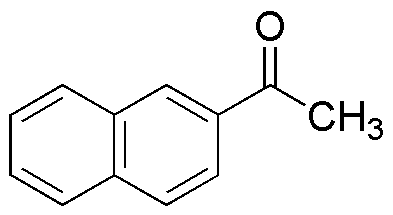2-Acetonaphthone is widely utilized in research focused on:
- Organic Synthesis: This compound serves as a key intermediate in the synthesis of various organic compounds, including pharmaceuticals and agrochemicals, enhancing the efficiency of chemical reactions.
- Photographic Chemicals: It is used in the formulation of photographic materials, contributing to the development of high-quality images due to its ability to absorb and emit light effectively.
- Polymer Production: 2-Acetonaphthone acts as a photoinitiator in UV-curable coatings and inks, allowing for rapid curing processes and improved durability in finished products.
- Flavor and Fragrance Industry: This compound is utilized in the production of certain flavors and fragrances, providing desirable aromatic properties that enhance consumer products.
- Research and Development: It plays a significant role in various research applications, including studies on chemical reactivity and photochemistry, making it valuable for academic and industrial laboratories.
General Information
Properties
Safety and Regulations
Applications
2-Acetonaphthone is widely utilized in research focused on:
- Organic Synthesis: This compound serves as a key intermediate in the synthesis of various organic compounds, including pharmaceuticals and agrochemicals, enhancing the efficiency of chemical reactions.
- Photographic Chemicals: It is used in the formulation of photographic materials, contributing to the development of high-quality images due to its ability to absorb and emit light effectively.
- Polymer Production: 2-Acetonaphthone acts as a photoinitiator in UV-curable coatings and inks, allowing for rapid curing processes and improved durability in finished products.
- Flavor and Fragrance Industry: This compound is utilized in the production of certain flavors and fragrances, providing desirable aromatic properties that enhance consumer products.
- Research and Development: It plays a significant role in various research applications, including studies on chemical reactivity and photochemistry, making it valuable for academic and industrial laboratories.
Documents
Safety Data Sheets (SDS)
The SDS provides comprehensive safety information on handling, storage, and disposal of the product.
Product Specification (PS)
The PS provides a comprehensive breakdown of the product’s properties, including chemical composition, physical state, purity, and storage requirements. It also details acceptable quality ranges and the product's intended applications.
Certificates of Analysis (COA)
Search for Certificates of Analysis (COA) by entering the products Lot Number. Lot and Batch Numbers can be found on a product’s label following the words ‘Lot’ or ‘Batch’.
*Catalog Number
*Lot Number
Certificates Of Origin (COO)
This COO confirms the country where the product was manufactured, and also details the materials and components used in it and whether it is derived from natural, synthetic, or other specific sources. This certificate may be required for customs, trade, and regulatory compliance.
*Catalog Number
*Lot Number
Safety Data Sheets (SDS)
The SDS provides comprehensive safety information on handling, storage, and disposal of the product.
DownloadProduct Specification (PS)
The PS provides a comprehensive breakdown of the product’s properties, including chemical composition, physical state, purity, and storage requirements. It also details acceptable quality ranges and the product's intended applications.
DownloadCertificates of Analysis (COA)
Search for Certificates of Analysis (COA) by entering the products Lot Number. Lot and Batch Numbers can be found on a product’s label following the words ‘Lot’ or ‘Batch’.
*Catalog Number
*Lot Number
Certificates Of Origin (COO)
This COO confirms the country where the product was manufactured, and also details the materials and components used in it and whether it is derived from natural, synthetic, or other specific sources. This certificate may be required for customs, trade, and regulatory compliance.


